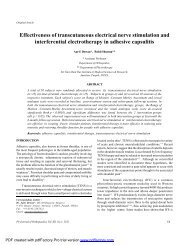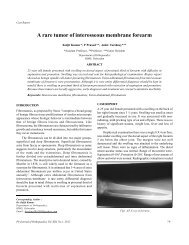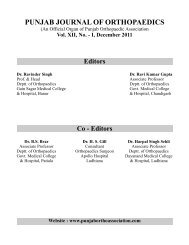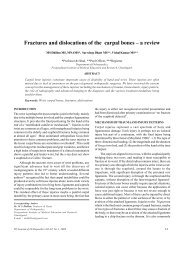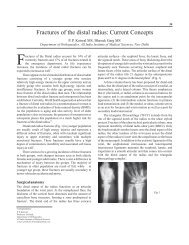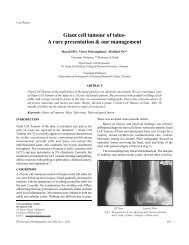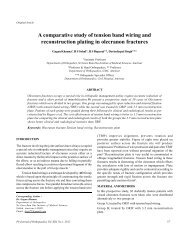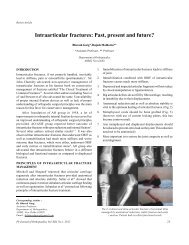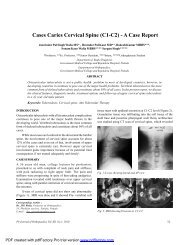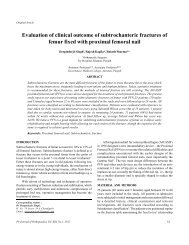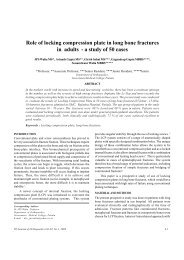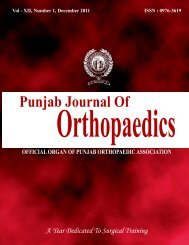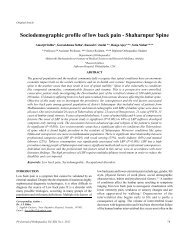Role of primary bipolar arthroplasty or total hip arthroplasty - Punjab ...
Role of primary bipolar arthroplasty or total hip arthroplasty - Punjab ...
Role of primary bipolar arthroplasty or total hip arthroplasty - Punjab ...
You also want an ePaper? Increase the reach of your titles
YUMPU automatically turns print PDFs into web optimized ePapers that Google loves.
Bipolar <strong>or</strong> <strong>total</strong> <strong>hip</strong> <strong>arthroplasty</strong> f<strong>or</strong> intertrochanteric fracture<br />
RESULTS<br />
A <strong>total</strong> <strong>of</strong> 50 elderly patients with intertrochanteric fractures<br />
underwent <strong>arthroplasty</strong> between 2008 and 2010. Mean followup<br />
duration was 21.8 months (range, 7-34months). No m<strong>or</strong>tality<br />
was noted. Mean age <strong>of</strong> patients was 69.04 years. Maximum<br />
number <strong>of</strong> patients was in the age group <strong>of</strong> 60-79 years<br />
comprising <strong>of</strong> 80% <strong>of</strong> <strong>total</strong> patients. In the <strong>bipolar</strong> group average<br />
age was 67.44 years, while in THR group average age was 70.64<br />
years. There were 38% female patients and 62% male patients.<br />
Patterns were similar in both the groups.<br />
In our Series 66% <strong>of</strong> intertrochanteric fractures were caused<br />
by min<strong>or</strong> trauma in the f<strong>or</strong>m <strong>of</strong> stumbling <strong>or</strong> fall on uneven<br />
surface and rest 34% cases by severe trauma in the f<strong>or</strong>m <strong>of</strong><br />
vehicular mot<strong>or</strong> accidents. Patterns were similar in two groups<br />
with min<strong>or</strong> trauma as cause in 60% in <strong>bipolar</strong> group and 72% in<br />
THR group.<br />
In present study, 64% cases were operated within 7 days<br />
<strong>of</strong> admission, 26% cases with in 8 to 15 days <strong>of</strong> admission and<br />
10% cases were operated after 15 days <strong>of</strong> admission in the<br />
hospital. The delay was mostly because <strong>of</strong> associated medical<br />
conditions. Hypertension was most common associated<br />
disease.<br />
The mean operative time in <strong>bipolar</strong> group was 50 minutes<br />
(range, 45-70 minutes). Average intraoperative blood loss<br />
was 120 ml (range, 90-25 0 ml) while in THR group mean<br />
operative time was 74 minutes (range, 60-100 minutes).<br />
Average intraoperative blood loss was 154 ml (range, 100-300<br />
ml).<br />
In Bipolar group 88% patients were allowed partial weight<br />
bearing within 7-14 days <strong>of</strong> operation 8% in third week and it<br />
was delayed till fourth week in one patient. In THR group 64%<br />
patients were allowed partial weight bearing within 7-14 days<br />
<strong>of</strong> operation 24% in third week and it was delayed till fourth<br />
week in 3 patients. Delayed weight bearing was due to<br />
comminution <strong>of</strong> fracture.<br />
In THR group 22 patients 88(%) were allowed full weight<br />
bearing within 4-6 weeks <strong>of</strong> operation. While in BIPOLAR group<br />
24 patients 96(%) were allowed full weight bearing within 4-6<br />
weeks <strong>of</strong> operation.<br />
At last follow-up in <strong>bipolar</strong> group, 3 cases (12%) had limp<br />
while walking. In THR group, only 2 cases (8%) had limp while<br />
walking.<br />
In THR series 2 cases had dislocations (8%), one happened<br />
after 2 weeks when patient slipped and fell; while in another<br />
case m<strong>or</strong>e than one year later in a road accident. Both were<br />
treated by closed reduction. This was followed by a 2-3 weeks<br />
period <strong>of</strong> immobilization with traction followed by guarded<br />
weight bearing. There were no dislocations in <strong>bipolar</strong> group.<br />
In our study <strong>of</strong> 50 cases outcome was excellent to good in<br />
all the cases as per Salvati and Wilson <strong>hip</strong> sc<strong>or</strong>e. Functional<br />
sc<strong>or</strong>es were slightly better in THR group (mean 34.16/40) when<br />
compared to <strong>bipolar</strong> group (33.60/40) but difference was not<br />
statistically significant (p value > 0.05).<br />
Mean Harris <strong>hip</strong> sc<strong>or</strong>e at final follow up was 82 in <strong>bipolar</strong><br />
group and 84.4 in THR group.<br />
DISCUSSION<br />
Hip fracture injuries are one <strong>of</strong> the most serious health care<br />
problems affecting elderly patients. There were an estimated<br />
1.66 million <strong>hip</strong> fractures w<strong>or</strong>ld-wide in 1990, this w<strong>or</strong>ldwide<br />
annual number will rise to 6.26 million by the year 2050 7,8 .<br />
In elderly the coexistence <strong>of</strong> unstable comminuted fracture<br />
with osteop<strong>or</strong>osis w<strong>or</strong>sen the prognosis 9,10 , which is attributed<br />
to presence <strong>of</strong> various co-m<strong>or</strong>bid conditions, which are<br />
exacerbated by immobility, bed rest and delayed weight<br />
bearing. In osteop<strong>or</strong>otic fractures, maintenance <strong>of</strong> reduction<br />
can be a maj<strong>or</strong> problem. Unsatisfact<strong>or</strong>y surgical outcome is<br />
common in elderly patients with intertrochanteric fractures;<br />
medical illness, osteop<strong>or</strong>osis, and fracture instability are<br />
contributing fact<strong>or</strong>s.<br />
The <strong>or</strong>thopaedic literature concerning the treatment<br />
and results <strong>of</strong> comminuted intertrochanteric fractures <strong>of</strong> the<br />
<strong>hip</strong> by Massie (1962) 11 , Holt (1963) 12 and Dimon (1973) 13 have<br />
shown outstanding w<strong>or</strong>k in an attempt to change an unstable<br />
fracture to a stable one and fix it with a specific device until it<br />
heals.<br />
Davis et al (1990) 9 studied the causes <strong>of</strong> mechanical<br />
failure in a series <strong>of</strong> 230 intertrochanteric fractures which had<br />
been internally fixed with either sliding <strong>hip</strong> screw <strong>or</strong> Kuntscher<br />
y-nail. The overall rate <strong>of</strong> mechanical failure was 16.5%.<br />
Kyle et al (1979) 14 rep<strong>or</strong>ting on a series <strong>of</strong> 74 unstable<br />
intertrochanteric fractures, had a post nailing complication rate<br />
<strong>of</strong> 6% to 8% and they could not ambulate their patients as late<br />
as four to six weeks due to the unstable nature <strong>of</strong> the implant<br />
bone construct. Hayward et al (1983) 15 rep<strong>or</strong>ted a failure rate <strong>of</strong><br />
35% using a nail plate combination and a failure rate <strong>of</strong> 37.5%<br />
using Enders nails.<br />
Kim et al (2001) 16 reviewed 178 intertrochanteric fractures<br />
treated by dynamic <strong>hip</strong> screw (DHS) fixation followed f<strong>or</strong> a<br />
minimum <strong>of</strong> one year. Unstable fractures with osteop<strong>or</strong>osis<br />
had a failure rate <strong>of</strong> m<strong>or</strong>e than 50%. They concluded in such<br />
cases, DHS should not be the first choice f<strong>or</strong> treatment.<br />
Pb Journal <strong>of</strong> Orthopaedics Vol-XII, No.1, 2011<br />
7<br />
PDF created with pdfFact<strong>or</strong>y Pro trial version www.pdffact<strong>or</strong>y.com



